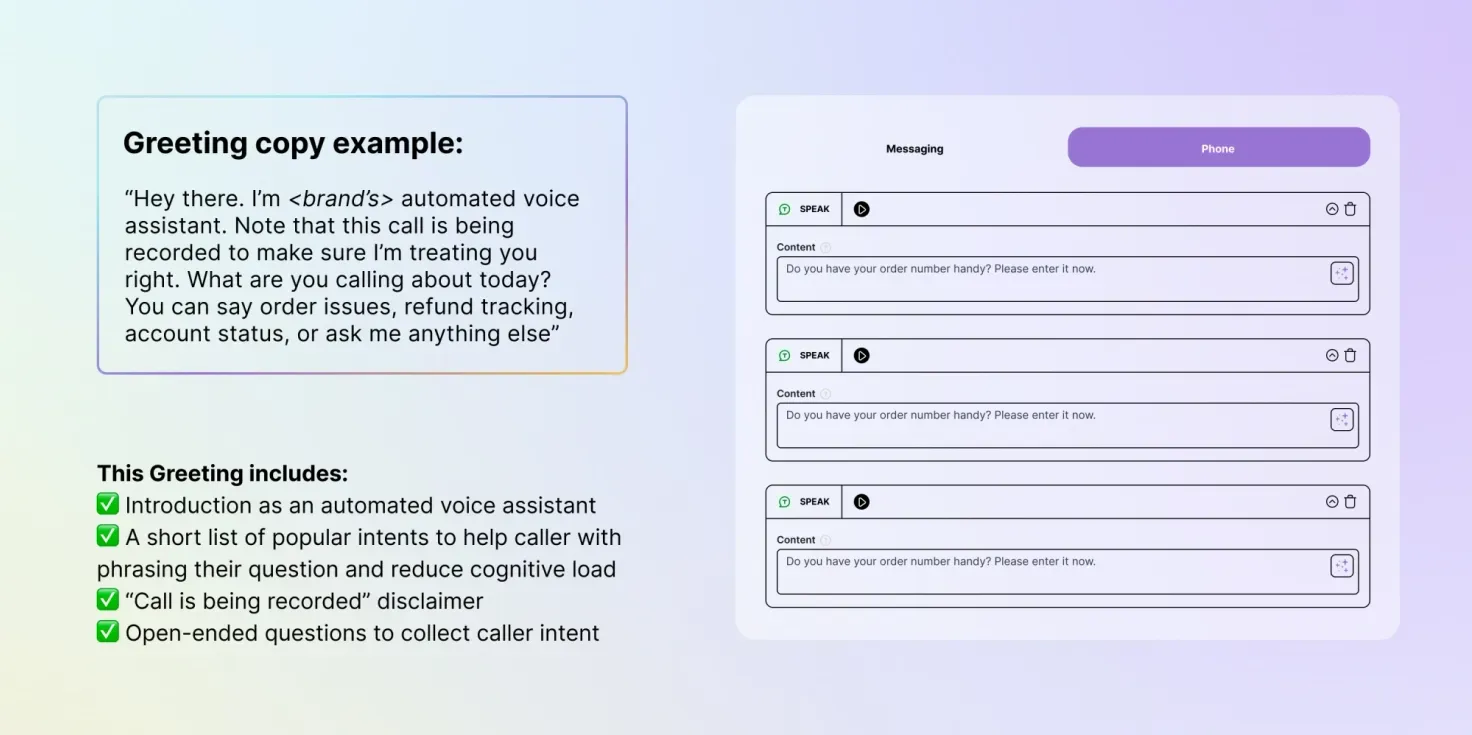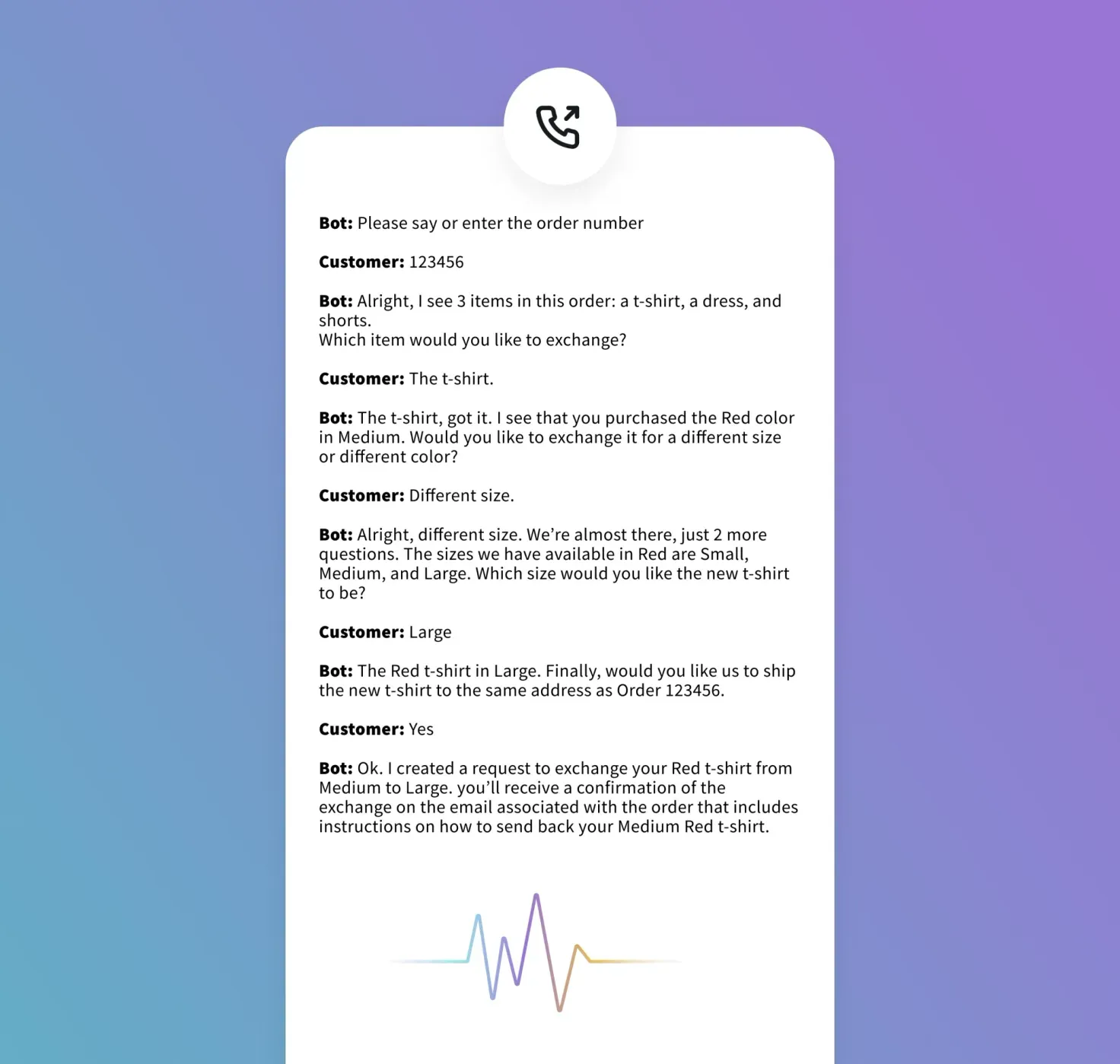
Guide to interviewing AI Agents
What makes an AI Agent different from the typical chatbots you’ve used in the past? Is the impact on ROI really that high?
Learn More

Phone support is still the most popular and most expensive customer support channel. Companies around the world are spending over $1.3T annually on customer calls. Needless to say, this is a channel that could benefit from automation powered by conversational AI.
Voice automation helps companies serve customers quickly and efficiently, reduce average wait times, save contact center costs, and provide a quality phone support experience.
"Voice automation is beneficial to both your customers and agents. We know that 63% of customer-facing teams say it’s challenging to find the time to build meaningful customer relationships. Leveraging AI to resolve repetitive tickets not only speeds up service for customers, but frees agents to devote more time to the high-impact conversations that are so important.” – Emily Gregor, Senior Content Marketing Lead, Aircall
But if you think you can port over all the conversation design principles you’ve learned so far, think again. There are special considerations to keep in mind for voice automation, some of which are different from the best practices on chat and messaging channels.
Overall, it's important to consider the limitations and challenges of phone interactions, such as decreased customer patience, tricky information capture, more unhappy paths, or caller demographics. Thoughtful design and scripting can help address these considerations and create a successful automated phone support experience for callers.
Without further ado, let’s dig into some of the conversational AI best practices we teach our own clients regarding voice automation for customer service:
The user persona is the profile of the person who will be using the phone to get in touch with your support team — i.e. “the caller”. Keep in mind that there’s a good chance that the caller is different from the user persona you may have defined for chat or messaging channels.
Understanding the caller and defining the parameters of this persona will guide your voice automation efforts and help you build more successful flows with higher resolution rates. Ask questions like:
The Greeting is the opening message that callers hear when they call the voice chatbot number or when they are transferred from an IVR to the voice automation platform. Getting the Greeting message right will invite callers to the conversation and guide them on next steps.
You can craft a great Greeting by following these steps:
We also strongly encourage creating a “Give the bot a shot” Answer. You’ll notice that many more people ask to speak with a live agent at the Greeting level in Voice than they do in Messaging. This is very typical caller behavior as most people who pick up the phone to contact support are expecting to speak with a person to resolve an issue that they believe requires a human touch. By defining the intents your Voice bot is equipped to handle, you will inspire more confidence in the bot’s abilities and encourage your caller to cooperate with the bot.

Phone calls require more attention from customers than chatting does. They’re either solely focused on the call and want to get through it as quickly as possible, or they’re multitasking and you only have a fraction of their cognitive processing abilities. Either way, brevity and clarity are the keywords when writing conversational AI flows for voice automation.
Conversational AI flows should get to the point quickly and allow users to dig for more context if required. Shorten the information you deliver and add a prompting question to the end.
Cognitive load is the amount of mental effort required to process information. As you’ve gathered by now, conversational flows for phone support have to deliver information with as little cognitive load on the caller as possible.
Writing succinctly will get you a long way towards that goal. Here are a couple of other tips to keep in mind too:
Send answers with heavy cognitive load to other channels. Sometimes an answer will inevitably contain a lot of information that is difficult to remember, such as an address or an order number. Wherever possible, it’s better to send this information to a text channel instead, such as SMS. This way the caller will not have to worry about looking for a pen or remembering a random string of words; they’ll have the information they need on hand whenever they want.
Don’t inundate callers with too many options at any one time. If you are prompting callers and want to give them multiple options to choose from, stick to 3 or 4 and offer them the ability to hear more if they want to.
Make sure callers know how to navigate their way through the automated system. Callers will want to pause, slow down, and repeat the content that is read out to them. Make sure your build incorporates these commands and that your callers know what the magic words are to trigger them. While you will do your best in your prompt-design to ensure that callers know what information to provide and how to provide it, you will also inevitably have situations where your callers are stuck in a state where they’re unable to cooperate with the prompt that is presented to them. Make sure your callers know the magic words that can get them out of these situations.
While this writing structure is a great format for conversation design on most support channels, it’s particularly important for voice automation.

Whenever you are prompting callers, make sure that the prompt clearly indicates how they should respond or what actions they can take. The more clarity you provide in exactly what information you need, and exactly how the caller should input it, the stronger your build will be. Example:
What is often helpful when determining how to build net-new voice automation flows is to see the use-case played out in dialogue. It becomes clear what information will be required to complete the happy-path of the flow, and allows you to call-out these requirements during the project scoping stage of implementation.
Once you’ve created your sample dialogue, remember to find a partner to read it back and forth with. It may sound silly, but you’ll be amazed at how hearing the intonation and speed of the interaction can highlight areas of content optimization.
Below is an example for determining what information is needed for an order exchange:

Add conversational markers to let callers know where they’re at in the conversation. Words like “first,” “almost there,” and “finally” help set expectations about how much longer this part of the conversation will last, or how many steps they may still have to go.
Keep error messages clear and informative to make sure the caller knows what went wrong and how they can retry.
Review your copy and refine verbiage wherever you can. Remember to optimize for brevity and clarity. If you’ve already built out automated flows for messaging channels in Ada, you can copy these over to Voice and adapt them instead of starting from scratch. I’ll dive into some best practices for adapting Messaging content to Voice at the end of this article.
Much like live verbal conversations, automated voice conversations must account for pauses. This is good practice when you need to collect information from a caller that they may not have on hand. There are some best-practices to keep in mind for length of pause when expecting input.
Let the caller know a pause is coming. If you need to collect an order number or a policy number, you can add a pause and let the caller know “I’ll give you a few seconds to gather this information before we start."
Plan out when to “timeout” the pause. There is an average length of time it takes between when the pause starts and when the caller ought to have started saying something. If that length of time passes and the caller hasn’t said anything, you should “timeout” the pause, i.e. say something to prompt the caller and make sure they are still on the line.
Figure out the timeout lengths. Depending on what the task at hand is, the time needs to be shorter or longer, and you need to make sure you’re accounting for the right length so that the bot and the caller don’t interrupt each other. Here are some examples of longer or shorter timeouts:
Use specific phrases when the timeout occurs. For example, rather than just “Can you repeat that?” or “I didn’t catch that” add something about the topic at hand like, “Can you please repeat your account number?” or “I didn’t catch that. What’s your account number?” You can also use these phrases to guide callers, for example, “Sorry, I didn’t get that. Your account number can be found at the top of your statement. Please say or type it in, or say, ‘I don’t know it.’”
You don’t always need to timeout the pause. Sometimes it can be appropriate to do nothing when there’s silence/when no speech is detected. This may be true when:
With well-designed conversational flows, you’ll be automatically resolving most of your customer inquiries. But there are certain cases that it would make sense to hand off the conversation to a live agent instead. These are the main 2 to consider:
If you’re already using Ada, you can easily copy all the automated flows you’ve already built for Messaging over to . With a few adaptations, you can deploy your new Voice bot in a few hours instead of having to build everything again from scratch.
Here are some considerations for adapting Messaging builds to Voice.
Evaluate how many of the existing flows in the Messaging lead to automated resolutions and determine how much of that can be automated in Voice. If many flows require handoff to live agents, it may result in lower containment rates for the voice bot.
This 2 minute clip has a good example of good barge-in design. Note the following:
Power 24/7, personalized experiences with Ada’s award-winning AI-powered automation. Increase agent efficiency, decrease wait times, and resolve more phone inquiries at a lower cost.
Learn more